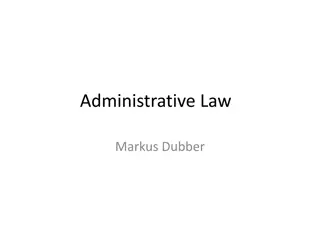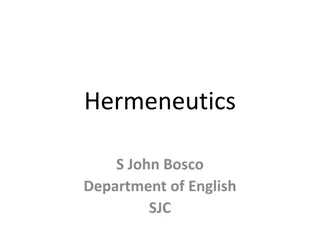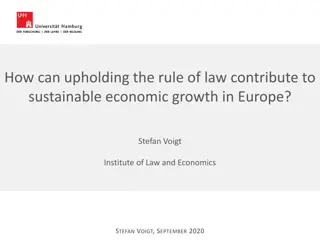Approaches to Statutory Interpretation: The Literal Rule
The Literal Rule in statutory interpretation mandates that all words in a statute be given their ordinary and natural meanings, even if the result seems absurd. This approach emphasizes following the clear wording of the law as enacted by Parliament. Advantages include respecting parliamentary sovereignty and defining a limited role for the courts, while disadvantages include potential injustice and impractical outcomes. Examples and critiques of the Literal Rule are discussed in the context of legal cases.
Download Presentation

Please find below an Image/Link to download the presentation.
The content on the website is provided AS IS for your information and personal use only. It may not be sold, licensed, or shared on other websites without obtaining consent from the author.If you encounter any issues during the download, it is possible that the publisher has removed the file from their server.
You are allowed to download the files provided on this website for personal or commercial use, subject to the condition that they are used lawfully. All files are the property of their respective owners.
The content on the website is provided AS IS for your information and personal use only. It may not be sold, licensed, or shared on other websites without obtaining consent from the author.
E N D
Presentation Transcript
Statutory Interpretation
Objectives Explainwhat is meant by the intention of Parliament. Identifythe problems that can arise when interpreting statutes. Explain the rules/ approaches of Statutory interpretation and apply to given cases. Explainthe aids and presumptions of statutory interpretation. Critically assessthe rules of statutory interpretation and suggest reforms. Discuss the relationship between statutory interpretation, EU law and precedent.
Statutory Interpretation What factors may cause the courts problems when interpreting statutes? What is meant by the intention of Parliament? Interpretation Act 1978.
Approaches to Statutory Interpretation In small groups give definitions for the following words: Vehicle Public place Consume
Approaches The Literal Rule Literal rule gives all the words in a statute their ordinary and natural meaning. Under this rule the literal meaning must be followed, even if the result is absurd: Lord Esherstated in R v City of London Court Judge (1892): If the words of an Act are clear, you must follow them, even though they lead to a manifest absurdity. The court has nothing to do with the question of whether the legislature has committed an absurdity .
Approaches The Literal Rule Examples of the literal rule in use are: Whitely v Chapell(1868) London & North Eastern Railway Co v Berriman(1946) Fisher v Bell (1961) Lees v Secretary of State (1985).
Approaches The Literal Rule Advantages of the literal rule Respects parliamentary sovereignty Gives the courts a restricted role. Disadvantages of the literal rule Zander in The Law-Making Processdescribes the literal approach as: mechanical, divorced from the realties of the use of language and from the aspirations of the human beings concerned in that sense it is irresponsible . Can lead to injustice and absurdity.
Approaches The Literal Rule R (on the application of Haw) v Secretary of State for the Home Department (2006): The Court of Appeal refused to apply a literal approach to a new piece of legislation as they felt it would not reflect the intention of Parliament.
Approaches-The Golden Rule If the literal rule gives an absurd result which parliament could not have intended, then AND ONLY THEN the judge can substitute reasonable meaning in the light of the statute as a whole. The grammatical and ordinary sense of the word is to be adhered to, unless that would lead to some absurdity in which case the grammatical and ordinary sense of the words may be modified so as to avoid that absurdity and inconsistency, but no further. Lord Wensleydale, Grey v Pearson (1857)
Approaches- The Golden Rule Examples of the golden rule in use: R v Allen (1872). Madox v Storer (1963). Adler v George (1964). Sweet v Parsley (1970). Inco Europe Ltd v First Choice Distribution (2000).
Approaches- The Golden Rule Advantages of the golden rule: Can prevent absurdity and injustice caused by the literal rule. Disadvantages of the golden rule: The rule provides no clear meaning of what is an absurd result.
Approaches - The Mischief Rule Laid down in Heydon s Case (1584), provides that judges should consider 3 factors: 1. What the law was before the statute was passed; 2. What problem, or mischief , the statute was trying to remedy; 3. What remedy Parliament was trying to provide.
Approaches - The Mischief Rule Examples of the mischief rule in use: Smith v Hughes (1960). Elliott v Grey (1960). Royal College of Nursing (1981).
Approaches - The Mischief Rule Advantages of the mischief rule: Avoids injustice. Promotes flexibility. Disadvantages of the mischief rule: Outdated, approach may be less appropriate now that the legislative process is different to Heydon s case (1584).
The Purposive Approach Lord Denning in Magor and St Melons Rural District Council v Newport Corporation(1952): We do not sit here to pull the language of Parliament to pieces and make nonsense of it we sit here to find out the intention of Parliament and carry it out, and we do this better by filling in the gaps and making sense of the enactment than by opening it up to destructive analysis
Aids to Interpretation Intrinsic Aids: The statute itself Explanatory notes since 1999 Rules of language : Ejusdem generis words of the same kind Expressio unius est exclusion alterius express mention of one thing implies the exclusion of another Noscitur a sociis a word draws its meaning from those around it
Aids to Interpretation Presumptions: 1. Statutes do not change the common law. 2. Legislation does not operate retrospectively. 3. Laws which create crimes should be interpreted in favour of the defendant.
Aids to Interpretation Extrinsic Aids: Dictionaries and textbooks Reports e.g. Law Commission. In Black Clawson International v Papierwerke Waldhof-Aschaffenburg(1975) the House of Lords stated that official reports may be considered as evidence of the pre- existing state of the law and the mischief the legislation was intended to deal with. Historical setting Treaties Other statutes/ cases Previous practice.
Aids to Interpretation Extrinsic Aids: Human Rights Act 1998 The Act incorporates into UK law the European Convention on Human Rights. Section 3 requires that : So far as it is possible to do so legislation must be read and given effect in a way which is compatible with the Convention rights.
Aids to Interpretation Extrinsic Aids: Human Rights Act 1998 Section 2 requires the courts take into account any relevant judgments from the European Court of Human Rights, but they are not bound by them. If impossible to find an interpretation which is compatible with the Convention the court can issue a declaration if incompatibility under section 4.
Aids to Interpretation to ignore Hansard would be to grope in the dark for the meaning of an Act without switching on the light . Extrinsic Aids: Hansard Davis v Johnson(1978) Pepper v Hart(1993),note the dissenting judgment of Lord Mackay Three Rivers District Council v Bank of England (No. 2) (1996) R v Secretary of State for the Environment, Transport, and the Regions, ex parte Spath Holme Ltd ( 2001) Wilson v Secretary of State for Trade and Industry ( 2003). Lord Denning
European Legislation Under Article 267 Treaty on the Functioning of the European Union, the Court of Justice of the European Union is the supreme court for the interpretation of EU law. Lord Denning in Bulmer v Bollinger (1974) said that when interpreting EU law the English courts should take the same approach as the European Court. No longer must they examine the words in meticulous detail they must look to the purpose or intent. To quote the words of the European Court in Da Costa they must divine the spirit of the Treaty and gain inspiration from it. If they find a gap they must fill it ..So must we do the same. Lord Denning
Effect of EU Membership on Statutory Interpretation Growth of a more purposive approach & effect of S2(4) European Communities Act 1972 all parliamentary legislation must be construed and applied in accordance with Union law: R v Secretary of State for transport, ex parte Factortame (1990).
Statutory Interpretation and Case Law Once the courts have interpreted a statute, that interpretation becomes part of case law in the same way as any other judicial decision, and is therefore subject to the rules of precedent.
Activities Welcome to the House of Lords: In small groups apply the rules of Statutory interpretation to given cases.
Useful Websites Hansard is available at: www.publications.parliament.uk/pa/pahansard.htm























